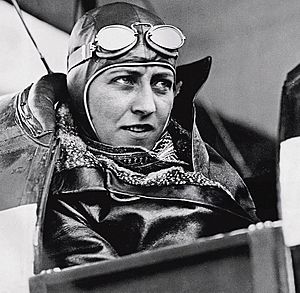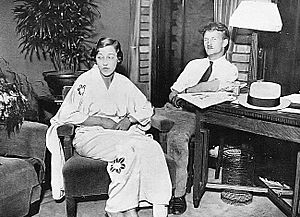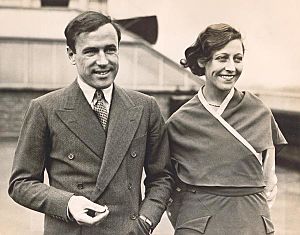Amy Johnson facts for kids
Quick facts for kids
Amy Johnson
|
|
|---|---|
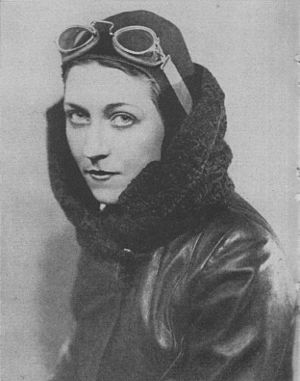
Amy Johnson c. 1930
|
|
| Born | 1 July 1903 Kingston upon Hull, East Riding of Yorkshire, England
|
| Disappeared | 5 January 1941 (aged 37) Thames Estuary, near Herne Bay, Kent, England |
| Status | Believed to have died in an aviation accident |
| Education | Boulevard Municipal Secondary School |
| Alma mater | University of Sheffield |
| Occupation | Aviator and Engineer |
| Spouse(s) |
Jim Mollison
(m. 1932; div. 1938) |
| Awards | Segrave Trophy (1932) |
Amy Johnson (born 1 July 1903 – disappeared 5 January 1941) was a brave English pilot. She was the first woman to fly alone from London to Australia.
During the 1930s, Amy set many long-distance flying records. She flew both by herself and with her husband, Jim Mollison. She also flew planes for the Air Transport Auxiliary during the Second World War. Amy disappeared during one of these flights, and the reason for her death is still talked about today.
Contents
Early Life
Amy Johnson was born in 1903 in Kingston upon Hull, England. Her family was well-known; her grandfather was once the Mayor of Hull. Amy was the oldest of three sisters.
She went to Boulevard Municipal Secondary School and then to the University of Sheffield. There, she earned a degree in economics. After university, she worked as a secretary in London.
Amy discovered her love for flying as a hobby. She earned her aviator's certificate in January 1929. Just a few months later, in July 1929, she got her pilot's license. In the same year, she became the first British woman to get a special license for ground engineering. This meant she could work on aircraft engines.
Amy was friends with Fred Slingsby, whose company made gliders in Yorkshire. She was an early member and trainee at the Yorkshire Gliding Club.
Aviation Adventures
Amy got money for her first airplane from her father and Lord Wakefield. She bought a used de Havilland Gipsy Moth plane. She named it Jason, after her father's business trademark.
In 1930, Amy became famous around the world. She was the first woman to fly alone from England to Australia. She left Croydon Airport on May 5 and landed in Darwin, Northern Territory on May 24. This was a journey of about 11,000 miles!
Her plane, Jason, is now on display at the Science Museum in London. For her amazing flight, Amy received the Harmon Trophy and was honored with a CBE award. She also received Australia's first civil pilot's license.
Amy then got a new plane, a de Havilland Puss Moth called Jason II. In July 1931, she and co-pilot Jack Humphreys flew from London to Moscow in one day. They flew about 1,760 miles in 21 hours. They continued their journey across Siberia to Tokyo, setting a new record for the flight from Britain to Japan.
In 1932, Amy married Scottish pilot Jim Mollison. He proposed to her during a flight, just hours after they first met! In July 1932, Amy set a new solo record. She flew from London to Cape Town, South Africa, in her Puss Moth, named Desert Cloud. She even broke her new husband's record!
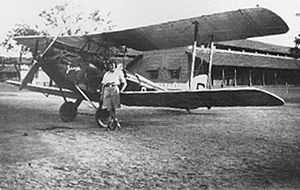
In July 1933, Amy and Jim Mollison flew a de Havilland Dragon plane called Seafarer. They flew non-stop from Pendine Sands, Wales, towards Floyd Bennett Field in New York. Their goal was to start a world record flight from New York to Baghdad.
They ran low on fuel and had to land early in Stratford, Connecticut. They crashed into a ditch but were not seriously hurt. After they recovered, New York celebrated them with a big parade.
In 1934, the Mollisons flew from Britain to India in their de Havilland DH.88 Comet, named Black Magic. This was part of the Britain to Australia MacRobertson Air Race. However, they had to stop the race in Allahabad due to engine problems.
In September 1934, Amy became the youngest President of the Women's Engineering Society. She was very active in the society until her death.
On May 4, 1936, Amy made her last record-breaking flight. She flew from Gravesend Airport to South Africa, regaining her record for that route. She was awarded the Gold Medal of the Royal Aero Club that same year.
In 1938, Amy had a small accident when landing her glider in England, but she was not badly hurt. That same year, she divorced Jim Mollison and went back to using her maiden name, Amy Johnson.
Amy started exploring other ways to earn a living. She tried business, journalism, and even fashion. She modeled clothes for designer Elsa Schiaparelli and had a travel bag named after her.
In 1939, Amy worked for a company flying short trips. She also flew as a target for anti-aircraft gunners to practice on. When the war started, her company's planes were taken by the Air Ministry, and Amy lost her job.
Second World War
Two months later, in 1940, during the Second World War, Amy joined the new Air Transport Auxiliary (ATA). This group transported Royal Air Force planes all over the country. She became a First Officer, working with her friend and fellow pilot Pauline Gower. Her ex-husband, Jim Mollison, also flew for the ATA during the war. Amy wrote a funny article about her daily life in the ATA, which was published after her death.
Disappearance
On January 5, 1941, Amy was flying an Airspeed Oxford plane for the ATA. She was flying from Prestwick to RAF Kidlington near Oxford. Bad weather caused her to go off course. She reportedly ran out of fuel and parachuted out of her plane as it crashed into the Thames Estuary near Herne Bay.
A group of wartime ships in the Thames Estuary saw Amy's parachute. They saw her alive in the water, calling for help. The weather was terrible: the sea was rough, the tide was strong, snow was falling, and it was extremely cold. Lt Cmdr Walter Fletcher, the captain of HMS Haslemere, tried to rescue her. His crew threw ropes, but Amy could not reach them and disappeared under the ship.
Some witnesses thought there was a second person in the water. Fletcher bravely dived in to help, but he became unconscious from the cold and died in the hospital a few days later. Amy's flying bag, log book, and cheque book were later found near the crash site.
A memorial service for Amy was held on January 14, 1941. Walter Fletcher was given the Albert Medal for his bravery.
Disputed Circumstances
Over the years, there have been different ideas about what happened to Amy. In 1999, a man named Tom Mitchell claimed that he accidentally shot down Amy's plane. He said she failed to give the correct identification code twice. He believed they thought it was an enemy plane.
In 2016, a historian claimed that a crew member's son said Amy died because she was pulled into the ship's propellers. However, the crewman did not actually see this happen.
Amy Johnson has no known grave because her body was never found. She is remembered at the Air Forces Memorial at Runnymede as a member of the ATA who went missing during the war.
Honours and Tributes
In June 1930, Amy's flight to Australia inspired a popular song called "Amy, Wonderful Amy". She was also the special guest at the opening of the first Butlins holiday camp in 1936. From 1935 to 1937, Amy was the President of the Women's Engineering Society.
Amy's father donated many of her souvenirs to Sewerby Hall in 1958. The hall now has a room dedicated to her. In 1974, a statue of Amy Johnson was put up in Hull. A girls' school there was also named after her. In 2016, new statues of Amy were unveiled to mark 75 years since her death. One was in Herne Bay, near where she was last seen. Another was in Hull, near her childhood home.
In 2017, The Guardian newspaper called Amy Johnson's bronze statue one of the "best female statues in Britain." Blue plaques and green plaques also mark places where Amy lived or was honored.
Several buildings are named after Amy Johnson:
- "Amy Johnson Building" at the University of Sheffield.
- "Amy Johnson Primary School" in Wallington, built on the old Croydon Airport runway.
- "The Hawthornes @ Amy Johnson" in Hull, a housing development on the site of the former Amy Johnson School.
- Amy Johnson Comet Restoration Centre at Derby Airfield, where her plane Black Magic is being restored.
Other tributes include a KLM McDonnell-Douglas MD-11 airplane and a Norwegian Air UK Boeing 787-9 named in her honor. "Amy's Restaurant and Bar" at Hilton hotels in London airports are also named after her.
"Amy Johnson Avenue" is a main road in Darwin, Australia. "Amy Johnson Way" is a road in Blackpool, UK, and also in York. "Johnson Road" is a road built on the site of the former Heston Aerodrome in west London.
In 2011, the Royal Aeronautical Society started an annual lecture named after Amy Johnson. It celebrates women in flight and honors her achievements. The lecture is held every year around July 6, the date Amy got her pilot's license.
Inmates at Hull Prison built a full-size model of Amy's Gipsy Moth plane. It went on public display in Hull in 2017.
In 2017, Google celebrated Amy's 114th birthday with a Google Doodle. The airline Norwegian painted her portrait on the tail fins of two of its aircraft. She is one of their "British tail fin heroes."
A mural reading "QUEEN OF THE AIR" (Amy's nickname) was painted at Cricklewood railway station. This honored 100 years since women got the right to vote in the UK.
St Mary's Church in Beverley plans to add a stone carving of Amy Johnson. This is part of a project to celebrate important women in the church's restoration.
In Popular Culture
Amy Johnson's life has been shown in films and TV shows. In 1942, a film called They Flew Alone (or Wings and the Woman) was made about her. Anna Neagle played Amy. Later, in 1984, a BBC TV film called Amy starred Harriet Walter.
Amy is also mentioned in other stories, like the 2007 film Ballet Shoes. In this movie, a character named Petrova is inspired by Amy's dream of becoming a pilot.
In music, Amy inspired songs like "Flying Sorcery" by Al Stewart. There are also older songs like A Lone Girl Flier and Just Plain Johnnie. Queen of the Air (2008) is a musical tribute to Amy.
Some fictional stories also feature Amy. A Doctor Who Magazine comic story in 2013 showed the Doctor meeting Amy in 1930. The character Worrals in books by Captain W.E. Johns was also based on Amy Johnson.
See Also
 In Spanish: Amy Johnson para niños
In Spanish: Amy Johnson para niños
- List of fatalities from aviation accidents
- List of female explorers and travelers
- List of people who disappeared mysteriously at sea
Images for kids
-
English Heritage blue plaque at Vernon Court, Cricklewood, London.


